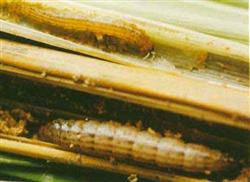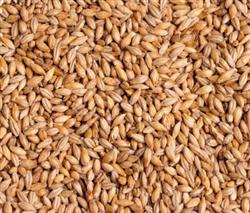How to control rice borer

How to control rice borer? Please guide the rice stem borer, commonly known as the heart borer, in which the most serious occurrence is mainly Chilo suppressalis and Chilo suppressalis, as well as rice bracts, Chilo suppressalis and so on. Stem borer harms not only rice but also corn, wheat and other gramineous crops. Chilo suppressalis is a monophagous pest, only to harm rice. The damage characteristics of borer can be divided into four stages: adult, egg, larva and pupa, and only the larva stage eats the rice stem. The larvae of Chilo suppressalis are light brown with five purple-brown longitudinal lines on the back, while the larvae of Chilo suppressalis are yellowish white or yellowish, and there is a green vertical line in the center of the back. The rice stem borer eats rice with its larvae, and the stem at the seedling and tillering stage forms a withered seedling or enters the leaf sheath, resulting in yellowish-brown stripes in the affected area, forming a "withered sheath". For example, when the stem is decayed at the booting stage, a withered ear is formed; when the stem is decayed after heading, a "white ear" is formed when the stem node is damaged, so that the yield is damaged; a "pest-damaged plant" is formed, resulting in minor losses. The borer moth hides among grasses or grasses during the day, moves at night, and has the habit of phototaxis and oviposition on tender green rice plants. During the tillering and incubation period, the newly hatched larvae first gathered in the leaf sheath to form a withered sheath, then the stem decay formed a withered heart, and the mature larvae pupated in the rice stem. Prevention and control methods 1. In order to control rice stem borer, we should adopt the first generation of Chilo suppressalis and the second generation of rice stem borer, and the third generation of rice stem borer. two。 Before the borer is fully hatched and pupated, only mud water is left in the field to reduce the harm of the ant borer or the position of pupation. After the peak of hatching or pupation, a large number of borer can be eliminated by pouring 13-16 cm deep water. 3. Chemical control: Cnaphalocrocis medinalis is controlled in the peak hatching period. Light occurrence, per mu with 1.8% avermectin 50 ml or 2.0% avermectin 45 ml, mixed with water 15-30 kg (depending on rice growth and insect conditions, as appropriate to increase water consumption), 15 days to spray again: re-occurrence (heavy generation), 1.8% avermectin 75-100 ml or 2.0% avermectin 70-100 ml per mu, spray again every 10 days. Rice stem borer (Chilo suppressalis) and Chilo suppressalis (Chilo suppressalis) must be treated hard for one generation, which can not only protect seedlings, but also depress the population density of the next generation. According to the characteristics of pesticides, we should control the withered sheath within 3 days after the ant borer hatched to the hatching peak, and control the injured plant, withered booting and white spike in all types of rice fields from the beginning of hatching to the peak of hatching. Choose medicament: prevent withered heart at seedling stage, spray swallow (1.8% avermectin EC50 ml + 40% isocarbophos EC50 ml) or Duiqing (2% avermectin EC50 ml + 40% isocarbophos EC50 ml) spray 30 kg of water To prevent white panicle of rice at heading stage, use Liyan (1.8% avermectin EC75-100ml + 40% isocarbophos EC75-100ml) or Diaqing (2% avermectin EC75-100ml + 40% isocarbophos EC75-100ml), spray 30kg of water; rice wax ripening stage pest control plants: use Liyan (1.8% avermectin EC100 ml + 40% isocarbophos). EC100 ml) or mixed with clear (2% avermectin EC100 ml + 40% isocarbophos EC100 ml), spray 30-45 kg water. Click to get massive rice planting technology click to get massive grain planting technology
- Prev

How to prevent and control rice stiff seedlings?
How to distinguish the advantages and disadvantages of rice seeds? Please guide how to distinguish the advantages and disadvantages of rice seeds can refer to the following methods: look at the uniformity to identify the irregular shape of seeds mixed with other rice, and the degree of fullness of grains is not the same. Look at the hull color to identify the grain color of the improved varieties should be more consistent, the color is relatively fresh.
- Next

How to manage planting corn?
How to manage planting corn? Please give suggestions that Rain Water is too much, and the occurrence of corn diseases and weeds will be more serious than in previous years. Therefore, the following suggestions are put forward for the planting and management of corn this year. 1. Strengthening the prevention and control of diseases at seedling stage due to more Rain Water, high soil moisture and lower soil temperature than normal years, the emergence date of maize will be similar.
Related
- The first cup of black tea in spring, the flavor and history of tea gardens in Kenya, Africa
- The computer can not only choose potatoes, but also grow tea rice. AI will grow winter oolong tea champion.
- It is not only the inflated tea bitten by insects, but also engraved with the four seasons tea in Beipu.
- The Oriental Beauty Tea Festival in Zhuxian County takes the stage at the weekend to experience the plus-size feast of oil tea.
- & quot; Oriental Beauty Tea & Exploration of Emei in Hsinchu, the hometown of quot;
- The new variety of strawberry "Tainong 1" dessert is the first choice with mellow aroma. Crimson gorgeous
- History of Tea in Taiwan: from Wild Inner Mountain to Export Tea Garden
- Two types of Taiwan Oriental Beauty Black Tea won the British three-Star Award for Childhood Tea Xiang Zhang Jiaqi changed from pilot to champion tea maker.
- Banana species and varieties: the planting history of Taiwan Xianren banana and dwarf banana is long, is banana disease resistant?
- Coffee planting Technology: Qianjie Coffee from Seedling to harvesting

